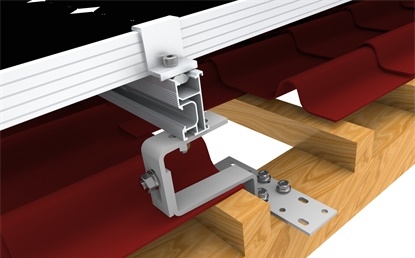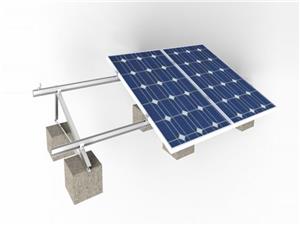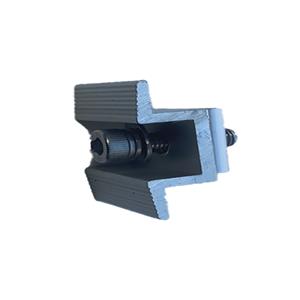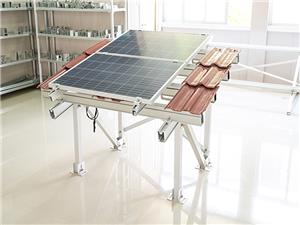What Is Solar Racking? Understanding Solar Installation Components
A solar racking system, or solar panel mount, is used to support a solar array on any surface, usually on a roof or directly on the ground. Rooftop mounts are usually less expensive because they can use the existing roof's structural support. However, ground-mounted systems are easier to access and maintain, and don't include the safety concerns that come with working on a roof.
Types of Mounts
On a roof, most mounts consist of a frame that is fastened to the structure of the roof's beams and rafters. If a roof-penetrating system is undesirable, such as on clay tile roofs, metal roofs, or a flat roof where water may pool, racking systems can be free-standing and ballasted.
Ground-mounted racking systems are either metal frames secured to a cement slab or are mounted on poles to allow for easier clearance below, such as in areas with heavy snow or in dual-purpose systems such as agrivoltaics, which integrate farming with solar panels.
Most racking components in both rooftop and ground-mounted systems are made of high-grade aluminum and stainless steel. An important consideration is the strength of the racking, which needs to support snow and high winds in many areas. A strong racking system might support up to 90 pounds per square foot snow load and 190 mph winds.
Rooftop Components

The three main components of a roof-mounted solar system are:
Roof attachments, which are fastened to the roof structure
Mounting rails, upon which the solar panels are mounted
Clamps, which attach the mounting rails to the roof attachments and the panels to the rails.
Roof attachments may vary, depending on the kind of roof. The most common roof attachments, used in shingle roofs, are drilled into the load-bearing beams and rafters of the roof, then sealed with flashing and sealant. On a seamed metal roof, roof clamps or brackets attached to the metal sheeting support the mounting rails.
A ballasted rooftop system consists of a rail-and-clamp frame except for the roof attachments, which are replaced with concrete blocks to hold the frame down. Some commercial frames come with ballasting components built into them. Because of their weight, ballasted systems only work on low-slope roofs, and many older roofs may not be able to support the extra weight.
Other components common to rooftop systems are conduit mounts, which lift the wiring off the roof to protect it from overheating.
Ground-Mounted Components
Ground-mounted systems that use frames are similar to rooftop systems, except that the frames are set into a concrete slab, which requires the extra steps of excavating, setting footings, and pouring cement. Many ground-mounted frames can be manually adjusted to maximize exposure to the sun.
A pole-mounted system uses a pole that is secured into a concrete-filled hole about half the length of the pole. Pole-mounted systems can either come with an automatic solar tracker or be manually adjusted. These systems may use multiple poles, which can support a larger panel array with a lower footprint than when attaching the frame directly into a concrete slab.
Components Common to All Racking Systems
Solar racking systems come with inverters that convert the direct current (DC) electricity that solar photovoltaic systems produce into the alternating current (AC) that residential and commercial buildings run on. Those inverters are sometimes built directly into the racking system, but in most systems, they are attached with clips.
Wiring runs through a solar array within the mounting rails, connecting the electrical junction box attached to the back of the solar panel with the system junction box.
Lugs, bolts, end caps, end clamps, wire clips, brackets, and various other mounting hardware are also common elements of any racking system.
Finding the Right Tilt
On a rooftop or ground-mounted frame that is not ideally angled for getting the most sun exposure possible, tilt legs can adjust the panels so that they are slanted at ideal angles to the sun, both horizontally and vertically.
The tilt angle is the vertical angle while the azimuth angle is the horizontal angle in relation to the equator. Setting the title angle is easy: Set it to your latitude. Finding the azimuth angle is somewhat more difficult.
In the Northern Hemisphere, panels should (almost always) face true south rather than the magnetic south, which can vary depending on Earth's magnetic field. You can find true south if you have a compass and factor in magnetic declination with NOAA's magnetic field calculator.
Costs
Rooftop racking can account for 10% of the total cost of an average rooftop solar system, or roughly $40 to $80 per panel, not including installation. By contrast, racking hardware for a ground-mounted frame system can cost $60 to $100 per panel. Since additional piping and concrete are required for a ground-mounted system, however, those costs can double.
A pole-mounted system with trackers is the most expensive option, costing up to twice as much as a ground-mounted frame system. The increased efficiency of solar panels using a tracker may make the extra upfront cost worth it, however.

:max_bytes(150000):strip_icc():format(webp)/GettyImages-610521250-430dc622479046e58f48352353a8b4fd.jpg)



